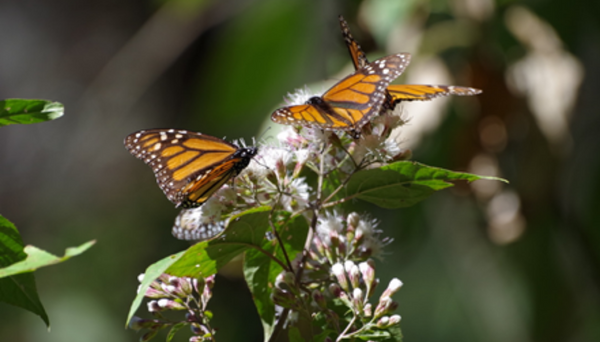Celebrating 25 Years of Trilateral Monarch Butterfly Conservation
In Morelia, Mexico, in late 1997, the Commission for Environmental Cooperation (CEC) convened its first North American Conference on the Monarch Butterfly, bringing together a diverse range of more than 300 representatives, spanning government, NGOs, academia, and Indigenous and local small-scale farming communities, among others, to identify and address priority conservation issues and actions for the monarch butterfly. With an ambitious goal of “establishing a North American conservation agenda”, the wide array of participants charted a path for a multidisciplinary and continental approach for protecting the iconic monarch butterfly.
Whereas previous international monarch conferences in the 1980s had focused primarily on the biology of the butterfly, the 1997 conference was a critical step forward for advancing a more integrated approach to monarch conservation. The organizers had extended special invitations to welcome the participation of often overlooked stakeholders, namely representatives from the local communities living in and around what is now the Monarch Butterfly Biosphere Reserve. For the first time, discussions brought the social, cultural and economic dimensions of monarch conservation into the foreground of the largely scientific and technical discussions.
This crucial conference 25 years ago built on decades of scientific work on the monarch butterfly and its unique annual migration, and helped fill knowledge gaps related to the interactions between monarch butterflies, humans, and the forest. Through a series of roundtable discussions on key topics and consensus-building, the participants agreed to a set of 53 priority actions.
Ranging from actions like developing alternative income and fuel sources for forest-dependent communities and establishing permanent training programs for local campesinos, to other solutions such as developing a student exchange program and “a strategy for long-term political support and national councils in all three countries,” the participants emphasized that actions to protect the monarch butterfly are “the shared responsibility of all three countries of North America.”
A decade later, these efforts coalesced with the development of the CEC’s 2008 North American Monarch Conservation Plan, which helped set the course of monarch conservation for North America. The plan had identified the main objectives at the time as: decreasing or eliminating deforestation in the overwintering habitat; addressing habitat loss, fragmentation and degradation in flyways and breeding habitat; promoting sustainable livelihoods for local populations; and monarch monitoring.
With each passing year, monarch conservation efforts and actions have increased our knowledge and the urgency for protecting this iconic species, the only butterfly known to complete annual bird-like migrations in North America. Research efforts have helped promote: data sharing to better understand the monarch’s biology, habitat, migratory pathways, and vulnerabilities across North America; the engagement of urban environments and local leaders through the expansion of the Mayors’ Monarch Pledge encouraging mayors to pledge local actions for protecting the species; the dissemination of an expansive collection of outreach tools, and resources and best practices; the engagement of individuals to help monarch conservation; and the expansion of participatory science initiatives like the International Monarch Monitoring Blitz; among many other items.
Despite these collaborative efforts, the migratory monarch butterfly is now classified as endangered on the International Union for Conservation of Nature Red List of Threatened Species, as both its eastern and western populations have declined significantly.
The migratory monarch butterfly, though facing new and continued threats, endures as a regal symbol of the borderless, cross-cultural, and timeless value of nature.
Although 25 years have passed since the North American Conference of the Monarch Butterfly, the vital efforts of North Americans working together to protect this cherished species and its miraculous migration must continue.

About the CEC
The Commission for Environmental Cooperation (CEC) was established in 1994 by the governments of Canada, Mexico and the United States through the North American Agreement on Environmental Cooperation, a parallel environmental agreement to NAFTA. As of 2020, the CEC is recognized and maintained by the Environmental Cooperation Agreement, in parallel with the new Free Trade Agreement of North America. The CEC brings together a wide range of stakeholders, including the general public, Indigenous people, youth, nongovernmental organizations, academia, and the business sector, to seek solutions to protect North America’s shared environment while supporting sustainable development for the benefit of present and future generations
The CEC is governed and funded equally by the Government of Canada through Environment and Climate Change Canada, the Government of the United States of Mexico through the Secretaría de Medio Ambiente y Recursos Naturales, and the Government of the United States of America through the Environmental Protection Agency.